Cats are recognized for their self-reliant and frequently lethargic disposition. Their penchant for lounging and sleeping can sometimes overshadow the necessity for regular physical activity. Despite their laid-back disposition, keeping your feline friend active is crucial for their overall health and well-being. Engaging them in play helps maintain a healthy weight and provides essential mental stimulation, preventing boredom and related behavioral issues.
Before we discuss tips and tricks for encouraging your lazy cat to play actively, let's first understand why some cats are lazy.
Understanding Lazy Cats
Some cats are naturally less active than others, often preferring to lounge around rather than chase toys. This behavior might label them as a lazy cat, but it's important to understand the underlying causes. Poor nutrition, lethargic pets often go unnoticed, even when they lack the energy to play. Considering how diet could impact a lazy cat’s activity levels is crucial.
To encourage a lazy cat, integrating cat toys and creating a cat obstacle course around the house can be beneficial. Food puzzles at mealtime can add an element of challenge and fun, while tunnels, cat trees climbing walls, and other physical exercise and mental stimulation tools can engage your cat. The time cats spend alone can lead to a lack of mental stimulation, so keeping cats interested in various activities is important.
Exploring more stimulating toys, like feather wands and toy mice to exercise wheels and puzzle games, can help teach them new tricks using kibble. The fine line between unwinding and being lazy, though, requires balancing play and treats, which can mean you're spending quality time with your pet while ensuring their physical and mental health.
how to get a lazy cat to play and be active- 13 tips you need to try
Encouraging a lazy cat to play can be challenging. It requires a combination of the right toys, routines, and a stimulating environment to pique their interest. But worry not—we prepared a comprehensive guide of games you can try that are physically and mentally stimulating. We'll help you get your cat to play and stay engaged.
Create a Play Routine
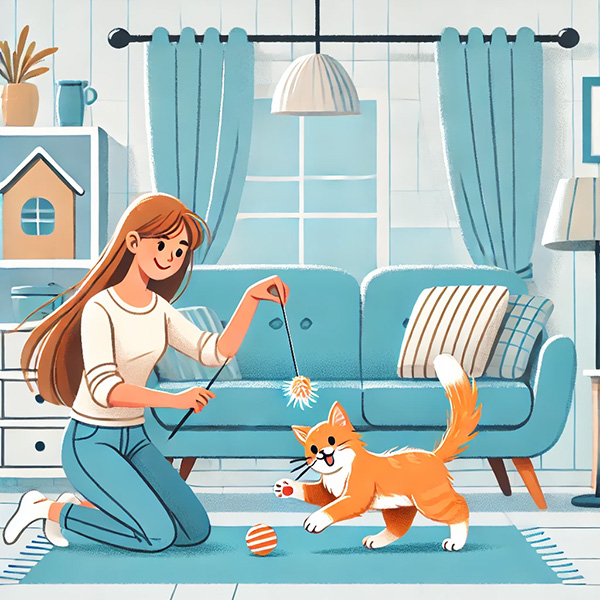
Establishing a consistent play routine helps cats anticipate and look forward to playtime. Cats love predictability and regular activity. You can choose optimal times for play, such as before meals or after naps, when your cat is naturally more active.
Having a routine helps avoid overfeeding, preventing sluggishness and health issues. Cat parents can use cat toys and create a cat obstacle course to keep their cats engaged and active. Incorporating mentally and physically stimulating activities ensures that cats remain playful, strengthening their bond with their owners and enhancing their quality of life.
Use the Right Toys
Interactive toys are great for getting your lazy cat to play. Consider using laser pointers, feather wands, and battery-operated toys to engage their natural hunting instincts. Laser pointers and moving toys are particularly effective for lazy cats. The erratic movement mimics prey, which captivates their interest and encourages play.
In addition, you may need to consider your cat's personality and preferences. Some cats prefer specific types of toys over others. Some cats like chewy toys, while others may enjoy feature toys. Ultimately, you want to find a type of toy that will excite your cat and get your lazy cat up to play.
Puzzle Feeders and Treat-Release Toys
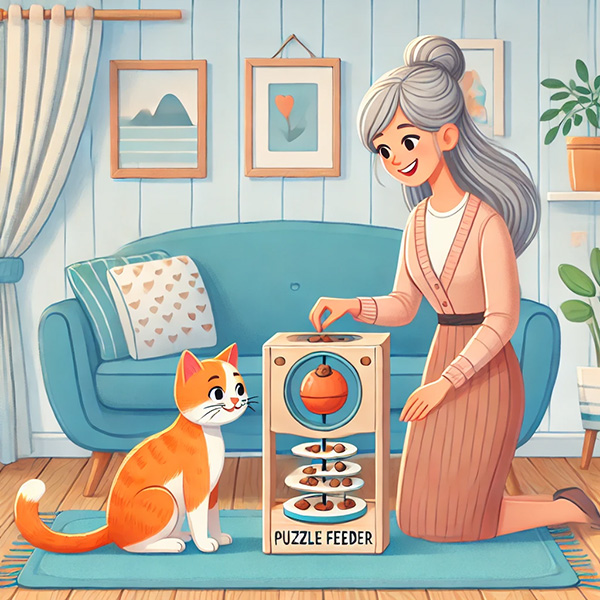
Incorporate puzzle feeders into your cat's routine to encourage movement and mental stimulation. Cats love the challenge of these feeders, which help prevent laziness and overfeeding while also promoting physical and mental health.
Puzzle feeders can be used to encourage cats to play alone and can be part of a larger cat obstacle course with tunnels and climbing structures. By integrating these engaging activities, you can transform the time cats spend alone into an enriching experience that maintains their energy levels and overall well-being.
Stimulate Their Prey Drive
Cats have an instinctive hunting nature. Toys that mimic prey can activate their hunting instincts. Use toys that move unpredictably to get them excited and moving. Consider toys that mimic the behavior of their natural prey. Popular options include laser pointers that dart and dance unpredictably, feather wands that flutter enticingly, and interactive mice that scurry and hide. Motorized balls that roll randomly also provide endless amusement and engage hunting instincts.
Create a Stimulating Environment
Cats are known for being independent and sometimes lazy, but this doesn't mean they don't enjoy a stimulating environment. Cats love having a particular location they prefer for play, and enhancing your home with vertical spaces like cat trees and shelves can significantly impact their activity levels. Vertical spaces offer opportunities for climbing and exploring for your feline friend.
Adding these elements requires a huge effort from pet parents to keep their cat engaged. An idle cat may look content lounging around, but a dynamic environment can lead to severe health benefits. Playthings they'll soon become familiar with can encourage even food-eating lazy cats to move more. Watching your cat jump for joy as they explore new heights will boost their energy levels and prevent the long-term health consequences of inactivity.
Obstacle Courses
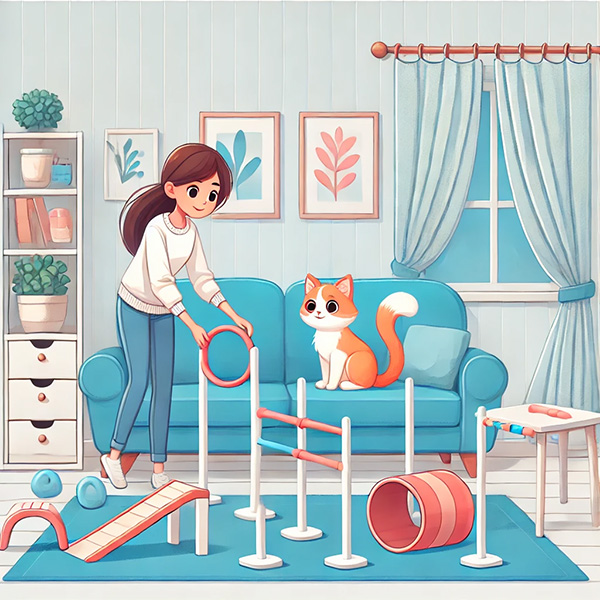
Set up obstacle courses with tunnels and hurdles to create a fun and challenging play environment. A cat obstacle course could stimulate their minds and encourage physical activity, leading to long-term health benefits. By integrating playthings, you can keep experimenting with toys to find those that most excite your cat.
Felines can greatly benefit from pet parents creating an enriched environment to explore more stimulating toys and activities. Use play and treats to encourage a cat to play alone or with you, ensuring they remain active and healthy.
Incorporate Treats into Play
Use treats strategically to motivate your cat. Reward-based play, where cats earn treats through activity, can be a powerful incentive for lazy cats. Hide treats around the house, use a puzzle box, or use treat-dispensing toys to encourage your cat to move and explore.
Rotate and Refresh Toys
Cats are naturally curious creatures and thrive on novelty, so they can quickly grow disinterested in toys that become too familiar. Rotating their toys regularly is beneficial to keep their playtime engaging and mentally stimulating. Introducing new toys can reignite a cat's interest, challenging their hunting instincts and problem-solving skills. This variety helps prevent behavioral problems and promotes physical and mental health, keeping them active and entertained. Swapping toys every few weeks can make old toys seem new again, keeping your cat's playtime fresh and exciting.
New and Unique Toys
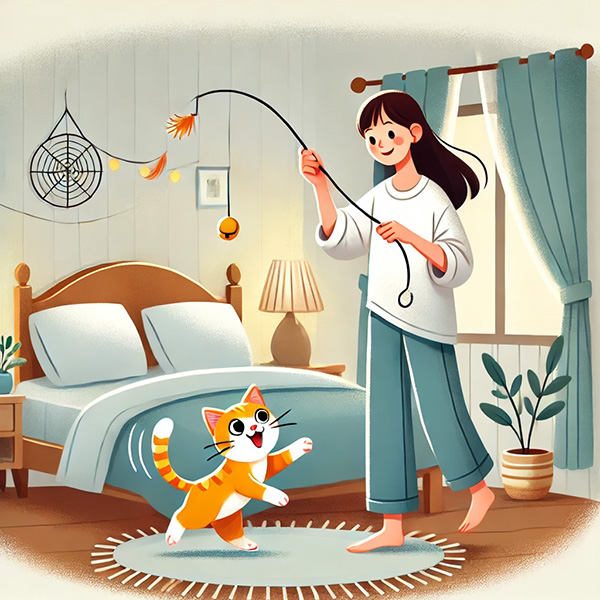
Investing in a diverse range of cat toys can significantly enhance playtime by appealing to different aspects of a cat's senses and instincts. Toys that vary in texture, such as soft plush toys, crinkly balls, or rough sisal mice, provide tactile stimulation that can be intriguing for a cat. Similarly, toys that produce sounds, like jingling bells or squeaking noises, can pique a cat's auditory curiosity.
Additionally, unpredictable toys, such as fluttering feathers on a string or a motorized bug that scuttles across the floor, can ignite a cat’s chase instinct. This variety engages your cat and helps fulfill their natural hunting and playing behaviors, contributing to their overall well-being and happiness.
Engage in Different Play Styles
To keep your cat engaged and prevent boredom, it's essential to mix up play styles by incorporating different types of games that cater to various aspects of their natural behavior. Alternating between chasing games, like running after a laser dot or a feather wand, can fulfill their hunting instinct. Introducing fetching games, where they can chase and bring back a small ball or stuffed toy, adds variety and encourages interaction.
Additionally, creating opportunities for digging games, such as hiding treats or toys in boxes filled with paper or within puzzle feeders, can stimulate their curiosity and problem-solving skills. This rotation of activities keeps playtime fresh and exciting and ensures a well-rounded exercise regime that is both physically and mentally stimulating for your cat.
Be Patient and Consistent
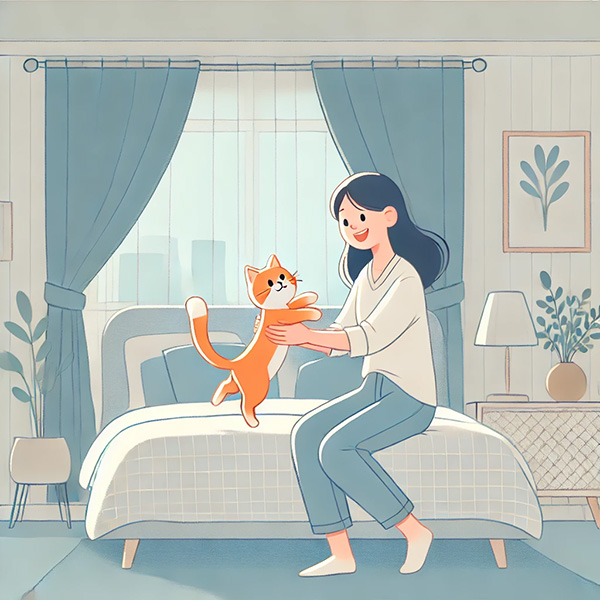
Patience and consistency are key. Finding what engages your cat may take time, but persistence will pay off. Cats love exploring different playthings. By creating a routine and sticking to it, you can help your cat develop a love for playtime that enhances their physical and mental well-being.
Observing Cat’s Preferences
Observe your cat's responses to various toys and activities. This will enable you to customize play sessions according to their preferences.
Use Technology to Your Advantage
Leveraging technology like cat apps and automated toys can be a great way to keep your cat entertained, particularly when you're not home to engage with them directly. Cat apps often feature moving objects on screen, such as fish or birds, which can captivate a cat's attention and stimulate their hunting instincts. Automated toys, such as laser towers or motorized mice, operate on timers or motion sensors, providing sporadic activity that can surprise and intrigue your cat throughout the day. These gadgets can play a crucial role in reducing boredom and separation anxiety for indoor cats by offering continuous mental stimulation and physical activity, ensuring they remain active and entertained even in their absence.
